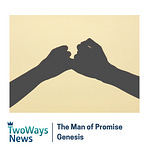My eldest brother Bob is a knockabout, Aussie kind of guy. He spent 20 years in the navy, and then ten years driving a truck in his own milk-delivery business. He’s a man with a great deal of practical intelligence, who likes to tease his younger brothers about being useless, smart-alec, university types (except he doesn’t say ‘alec’).
In Bob’s mind, there are two types of man: those who would survive on The Walking Dead and those who wouldn’t.
There’s no doubt which category I’m in.
I’d still be drafting a blog post on the theological implications of zombie-ism when they started eating my brain. I suppose you could say I’m more of a smooth man than an hairy man.
Then again, smooth-man Jacob was an interesting sort of guy. He was a mummy’s boy who hung around the tents and liked to cook, but also an intrepid traveller, a hard-working entrepreneur and canny negotiator. Very few people ever got the better of Jacob (not in the long run anyway). He was the kind of man who wrestled all night with God and refused to yield.
Was Jacob less of a man than Esau, or just a different sort of man? Would he have survived in The Walking Dead by persuading the zombies to eat his brother instead?
Just what sort of thing is ‘masculinity’? Is it defined by certain tastes—football, fishing and meat pies, as opposed to poetry, guitar-playing and salads? (If so, I’m confused, because I enjoy all those things.) Or is masculinity really about certain personality traits or physical attributes?
It’s a bit hard to say, because although it’s beyond obvious that men are somehow different from women, what constitutes that difference is tough to nail down.
This has led our culture in some interesting and contradictory directions over the past several decades.
40 years ago, say, in the heyday of Third Wave Feminism, the culturally popular way to answer the question was to say that whatever differences did exist between men and women were purely the result of cultural conventions—and that therefore there was nothing in principle a man could do that a woman could not also do (and possibly better). We just needed to get over our sexism and our cultural prejudices. Are men brave courageous warriors? Women can be too. Are men leaders, CEOs, firefighters, detectives and football stars? Women can be too.
The trend was to flatten the distinctions, to insist that we were all just people, and that everyone should be treated the same way, afforded the same opportunities, and so on. Glass ceilings needed to be shattered. If there was something men were prominent in or seen to be good at, then why not women?
Now, we won’t go into the positives and negatives of this brand of feminism at this point, except to say its main ideas have now become a normal and accepted part of our culture. It’s why we are all supposed to care so much about professional women’s football and cricket these days. It’s why nearly every lead detective in a British crime drama these days is a woman. It’s why Galadriel in the Amazon Prime series The Rings of Poweris such a strange and dissatisfying character. She’s really a male character in a dress—steely-eyed, hot-tempered, obsessed with her goal, a peerless warrior who is biased towards action and fighting as the solution to most problems. I think we’re all supposed to cheer for her and think she’s a wonderful, powerful woman. It feels fake and kind of played out to me.
Third Wave Feminism led to some interesting challenges for men—say from the 1980s onwards. If pointing out differences between men and women was now chauvinism and sexism, and there was nothing distinctively masculine that couldn’t just as well be feminine, then what did it mean to be a man? Anything at all? Does our family now kind of have two dads? Or is it two mums? And is there any difference?
Since then, the landscape has only become more complicated, if that is possible. The main tenet of today’s identity-politics feminism is not so much to flatten the distinctions between men and women as to magnify them.
Masculinity seems to exist again. (After all, it’s possible for it to be trapped in a woman’s body). But now it exists mostly to be belittled or attacked. You can put the adjective ‘toxic’ adjacent to masculinity in a way that is impossible to do with ‘femininity’.
It’s still sexist to make any generalizations about women as class, but men? It’s perfectly fine to stereotype them, and frequently in a negative way, either as touchingly useless morons or as controlling abusive dominators. You could say that ‘masculinity’ is a thing again; just not a terribly good thing.
It’s a brave man who ventures into this confusing and conflicted landscape and seeks to rescue the idea of ‘masculinity’ from its cultural despisers, and put forward a positive hopeful vision of what ‘masculinity’ is and could be.
That’s what Al Stewart has done in his new book The Manual: Getting Masculinity Right. And he has done it very well.
Al succeeds in being warm, funny and real about the struggles and joys of being a man. He doesn’t ignore the problems that men commonly face or the evils that men commonly perpetrate. He doesn’t hark back to a golden age when ‘men were men’ and try to recreate it somehow. He keeps turning to God, the creator of men and masculinity, to listen to what he has to say about the subject. And he drives his argument towards Jesus, the man who came to rescue and deliver men (and women) from their sins and failings, and to present a vision of true humanity that we can follow.
In the first half of the book, Al looks at the cultural moment in which men find themselves, at the common attacks on masculinity, and at the particular challenges men face in growing up from boyhood to manhood. He also interacts with some of the psychological and sociological research that seeks to understand the underlying realities that the descriptors ‘masculine’ and ‘feminine’ refer to.
Following cites the work of Alan Medinger, who suggests that the ‘masculine’ can only be understood in relation to the ‘feminine’, along four continuums or scales:
outer-directed vs inner-directed (the masculine is more oriented to things in the world, to exploring, building, overcoming; the feminine is more activated by the inner life of sensing, knowing, feeling and relating);
initiation vs response (the masculine starts projects, invents things, initiates relationships; the feminine tends to respond, encourage, and join);
leadership vs cohesion (the masculine strives to lead and push things forward; the feminine is more oriented to holding things together);
truth vs mercy (the masculine seeks truth, stands on principle, and thinks about long-term consequences; the feminine is more moved by compassion and immediate human need).
Overall, the masculine is more oriented to doing, the feminine to being.
The point that Al takes from this is that we are all at various points along these continuums, and that we all exhibit both masculine and feminine traits to some extent. It’s not as if women never initiate, invent things or care about truth, or that men are never encouraging, compassionate or activated by an inner life.
However, in universal human experience, men do cluster more on one side of these continuums, and women on the other. The masculine traits tend to predominate in men, and the feminine in women—across time and cultures.
Our problem culturally over the past 40 years (it seems to me) is that we either deny this insight, or else interpret it in an entirely negative way.
On the one hand, Third Wave Feminism denies the existence of such traits, or at least any sense that they predominate by nature in one sex or the other. Women can (and should) be just as outer-directed, activist, and leadership-focused as men. To suggest otherwise is apparently to say that women are inferior (which seems a strange conclusion to draw, as if the masculine traits are somehow the superior ones).
On the other hand, more recent intersectional feminism does accept the reality of masculine traits predominating in men, but sees them only in their most ugly extremes—as violence, coercion, greed, domination, rape culture, and so on. It's as if men have been pushed (as a class) to the dysfunctional end of each of these continuums.
Al’s treatment of this whole delicate subject is impressive. He resists caricature and cheap shots, and yet succeeds in naming the obvious realities we experience every day—and in a way that not only critiques the current distortions but shows a hopeful and holistic way forward.
All the same, there are some questions he leaves unanswered. If you happen to be one of those men with more than the average male share of feminine traits, does that mean that you should seek to display more of the masculine? Or just accept that the mix of traits in you is a bit different? (Ditto for women of course.)
Al doesn’t address this question head on. His main purpose is to redeem masculine traits as good and worthwhile, to encourage men to embrace them (rather than see them as our society tends to do, as evil or non-existent), and to urge men to ‘man up’ for the sake of others; to live out their masculinity in a godly, loving way in the various relationships they find themselves in.
In some ways, the first half of The Manual reads like a wiser, funnier, more biblical Jordan Peterson. It looks at the nature of men and masculinity as creational realities, and seeks in wisdom to understand those realities. The Bible’s framing of this wisdom is seen as important, but is not overplayed. And this is a strength—because the Bible has surprisingly little to say about ‘masculinity’ or ‘manhood’ per se. As Al explores that subject in the first half of the book he doesn’t try to squeeze more out of the Scriptural lemon than is there. He points to how God has answers for the problems and struggles that men face, and that the Bible does teach men how to be godly men in the various relationships we are in, but he leaves the detail of those answers to later in the book.
Early on, however, he does propose a definition of healthy masculinity that serves as the driving theme throughout the book:
Healthy masculinity is a willingness to take responsibility and use the power you have to care for and nurture those around you.
In this sense, healthy masculinity is a version of healthy humanity, because this is what humans were created for: to love God and to love their neighbour. But we do so as men and women, and the second half of the book teases out how men in particular should do that in the various relationships they inhabit.
This second half has a lot more Bible in it, because it deals with the subjects that the Bible has far more to say about—namely the relational contexts in which men are husbands, brothers, sons, fathers, workmates, and so on. Al turns to these many passages in the second half of the book, as he explores what it means to be a man in all of these spheres. It’s very well done—driven by the biblical passages, good-humoured, wise and compassionate in the way they are applied, and concluding with a powerful challenge to follow the Man who makes living as a good man possible.
I’m pleased Al has been man enough (if I can put it that way) to write this book. It exemplifies what he himself argues that masculinity is really about—taking responsibility to use whatever resources or strength or wisdom you have at your disposal for the sake of others.
The ‘others’ who will benefit from this book are many. I’ve read and discussed it with the male trainees at Campus Bible Study. I’d like to see every young man in our churches read it—or better yet, see them get together with some older men to read and talk through together. It’s also the kind of book you could give to a non-Christian friend.
And if the kind of man you have in mind who would benefit from this book is not really a reader, then the Audible version is coming in the New Year.
I think I might even send it to my brother Bob.
PS
The cheapest way to buy The Manual is in quantities of two or more direct from Matthias Media (you get 20% off for 2-24 copies; 40% off for 25+ copies.) Never mind ‘betting with mates’; try ‘reading with mates’.
Here's a PhD for someone to do sometime: the presentation of gender among detectives in British crime dramas as a barometer of cultural change (1980-2020).
Ali and I love to flop down on the weekend in front of a British cop show—starting with The Bill back in 80s, and then on through Prime Suspect, A Touch of Frost, Silent Witness, Lewis, and all the rest, down to more recent series like Vera, Unforgotten, Shetland, Scott & Bailey, Line of Duty, and so on.
It’s impossible not to notice the steady feminization of British TV policing over this period. It's very much the exception now that a male character will be the lead detective—or if he is, he will either be a highly dysfunctional nightmare who is constantly rescued by his female sidekick (David Tennant's character in Broadchurch), or else a sensitive soul who is constantly crushed emotionally by the demands of the job (like Kenneth Branagh's Wallander or Douglas Hensell's character in Shetland).
Mostly though, it's now women as the lead detective (often but not always lesbian), with men as their faithful sidekicks. If there’s a uselessly incompetent officer who is always cutting corners or letting the team down in some way, it will invariably be a man. And there’s also frequently a male dinosaur in the office who resents not being in charge and hates taking orders from a woman (just so we don’t forget that this is the attitude we must avoid).
Many of these shows are excellent—we’ve really enjoyed Vera and Unforgotten and Scott & Bailey. But there’s increasingly a formulaic orthodoxy to the portrayal of men and women that is, ironically, every bit as stereotyped and chauvinistic as the male-dominated culture it is seeking to leave behind.
(“Are you glad you’ve got that off your chest?” said Ali, as she read a draft of those last few paragraphs. I suspect she is hoping she might enjoy our Saturday night TV in peace from now on, without me interrupting the flow with rants.)
Thanks for getting in touch with feedback on our first three editions. We appreciate the encouragement and the interaction—some good questions have been raised, and we'll get to them soon.
This week’s cover image is of the masculine man at the far end of every continuum: Chuck Norris. My favourite Chuck Norris jokes include:
When the Boogeyman goes to sleep every night, he checks under his bed for Chuck Norris.
Time waits for no man. Unless that man is Chuck Norris.
Chuck Norris doesn't read books. He stares them down until he gets the information he wants.
Chuck Norris doesn’t worry about high petrol prices. His vehicles run on fear.












